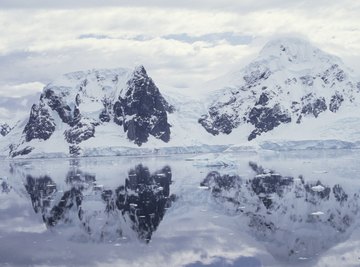
Convolutions of terrain tend to make for significant complexities in airflow. Anyone who’s rambled upland moors, alpine plateaus and glacier-sharpened ridge spines is well-acquainted with highland winds, which can be ferocious, frigid and desolating. While many such breezes and gusts stem mainly from variations in atmospheric pressure, some are simply the gravitational tumble of air parcels -- called katabatic winds.
Katabatic Winds
Katabatic winds are also occasionally referred to as gravity-driven winds, a moniker that concisely explains their nature. They form as cold air over snowy uplands spills downward into adjacent lowlands; air becomes denser with decreasing temperature, and thus succumbs to gravitational tug. The common name derives from the Greek word “katabaino,” which translates to “descending.” Katabatic winds are similar to a host of other localized air movements in rugged country, such as the daily and nightly reversals of mountain and valley breezes, but the latter arise because of pressure differences due to differential solar heating. Foehn, Chinook and Santa Ana winds are also related in effect but are powered partly by exceptionally severe pressure gradients between windward and leeward slopes of a mountain divide.
Locations
Katabatic winds are most significant in the two parts of the world with grand continental ice sheets: Greenland and Antarctica. Those huge frozen plateaus -- the last remnants of the enormous ice bodies of the Pleistocene glaciations -- reliably generate katabatic air movements along their margins. Similar winds, however, may be encountered in cold, snowy mountainous terrain throughout the world, from Turkey to Patagonia.
Extremes
Where katabatic winds sloughing off a high plateau or icefield are funneled into a valley or fjord, they may gain terrific speed -- beyond 220 kilometers per hour (140 mph). Such gales in chronically afflicted areas have typically earned their own special name. The “mistral” roars off the Alps to the Mediterranean Sea via the Rhône Valley; “williwaw” is used to describe katabatic pulses off the ice-bound highlands of Tierra del Fuego or southern Alaska, where “taku” is also applied to them. Such fierce katabatic winds can be dangerous; williwaws, for example, have long menaced mariners in the difficult circumvention of Cape Horn.
Ecological Impacts
In Antarctica, katabatic winds pouring down valleys can keep certain ones barren of snow -- a rarity in the interior of this icy continent. Those barreling off the coast shove sea ice offshore, maintaining open nearshore patches called “polynyas.” Given particular configurations of terrain and current, such open water may last even through the winter, as in Terra Nova Bay -- where katabatic winds flush away sea ice and the Drygalski Ice Tongue to the immediate south blocks wave-driven ice from replacing the cover.
References
About the Author
Ethan Shaw is an independent naturalist and freelance outdoors/nature writer based in Oregon. He holds a B.S. in Wildlife Ecology and a graduate certificate in G.I.S. from the University of Wisconsin-Madison. His primary interests from both a fieldwork and writing perspective include landscape ecology, geomorphology, the classification of ecosystems, biogeography, wildlife/habitat relationships, and historical ecology. He’s written for a variety of outlets, including Earth Touch News, RootsRated, Backpacker, Terrain.org, and Atlas Obscura, and is presently working on a field guide.
Photo Credits
Tom Brakefield/Stockbyte/Getty Images
